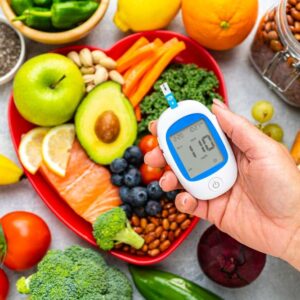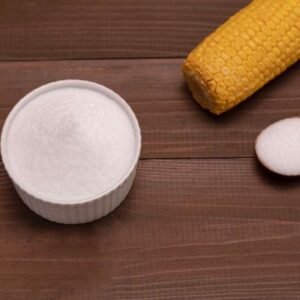
Toxins Found in This Common Pill (and the FDA Knows It)
- The FDA’s lack of concern for consumer health is a hard pill to swallow
- Is your DNA being mutated every time you pop a pill? Find out…
- Three quick steps to keep inflammation, heart disease, and diabetes out of your health regime.
Dear Reader,
Most folks don’t mind parting with a little cash for products they think may improve or ensure their health.
But the problem is some products are doing more harm than good.
In fact, you may have a few examples of these products around your house — I know I do.
I have tried everything from Himalayan salt lamps to detoxing foot pads to boost my health.
While most people don’t go to these extremes to keep their health in check, there is a product that over half of Americans purchase with the hope for better health.
And they pay for it — in more ways than one.
According to the National Institutes of Health, Americans spend an estimated $5.7 billion every year on just this one pill .1
The problem is it comes at more than just a monetary cost to the consumer.
You see, this product can be full of worthless and even dangerous fillers and additives. We will reveal some of the toxic additives in a bit and of course how to avoid them.
But to be clear, most capsules have fillers, but not all fillers are dangerous. Just the ones with proven negative health outcomes.
In the best case, these fillers add no nutritional value. At worst, they a can contribute to serious health risks like heart disease, diabetes, inflammation, and even DNA damage.
And since the FDA has approved these fillers for use in foods, drugs, and supplements, it isn’t going to save you, either.
Instead, it will sit on the sidelines while these “healthy” little pills bring in the billions and the manufacturers keep throwing toxins into them.
![]() So what are these risky remedies?
So what are these risky remedies?
Multivitamins.
Today, we will share with you three of the health dangers tucked away in your everyday pills and share ways to avoid them.
But first, let’s get to the dangers…
![]() Heath Danger #1: Artificial Colors
Heath Danger #1: Artificial Colors
Many gummy vitamins — for both children and adults — have artificial colors in them.
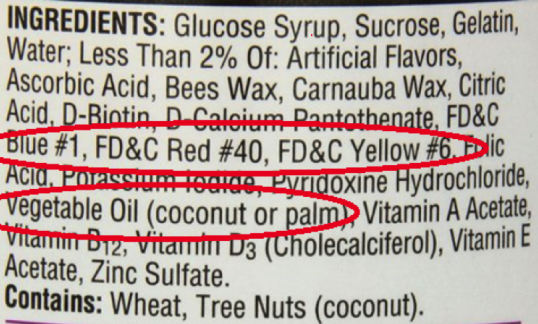
The list of ingredients for a popular kids gummy vitamin.
Source: Amazon.com
You may be wondering: What are artificial colors doing in my vitamins?!?
Well, the FDA (which approves the use of synthetic colors in foods as well) reports the following explanations for why artificial colors are in your vitamins:
1) To offset color loss due to exposure to light, air, temperature extremes, moisture, and storage conditions; 2) correct natural variations in color; 3) enhance colors that occur naturally; 4) provide color to colorless and “fun” foods. 2
I’m not sure why anyone’s vitamin needs to be “fun.” But the bigger concern here is that these artificial colors could be masking the degradation of active ingredients due to moisture, light, or heat.
Plus, the FDA once investigated the link between Red #40 and ADHD in kids but hasn’t acted. However, the European Union has already issued warning labels for six artificial colors because of their link to ADHD.3,4 Not to mention other artificial colors have been linked to cancers in the past.4
You might think these reasons would be enough for the FDA to ban this synthetic garbage from making its way in to any product, yet artificial colors are still in countless foods and vitamins.
Thanks, FDA.
However, artificial colors might be the least of your worries. This next filler has a reputation for wreaking havoc on your health.
![]() Health Danger #2: Hydrogenated Oils and GMOs
Health Danger #2: Hydrogenated Oils and GMOs
All types of vitamins — capsules, tablets, softgels, and gummies — may have hidden hydrogenated oils (and partially hydrogenated oils) or GMO products hidden in them. These include corn and soybean oils.
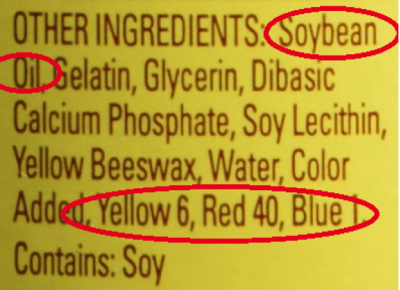
Soybean oil and artificial colors are found in this adult daily multivitamin.
Source: Amazon.com
Partially hydrogenated oils, aka trans fats, can lead to a whole host of dangerous health problems including heart disease, stroke, inflammation, diabetes, and other chronic conditions, because they raise your low-density lipoprotein (LDL), or “bad” cholesterol, levels.5
And even if the soybean or corn oil in your multivitamin isn’t hydrogenated, it’s almost certainly GMO if you aren’t choosing an organic or GMO-free source.
We all know GMO’s are bad, but they may not be as scary as the next nasty toxin…
Metal.
![]() Health Danger #3: Titanium Dioxide
Health Danger #3: Titanium Dioxide
Titanium dioxide is often used as a coloring agent in both supplements and cosmetics. However, this pigment comes at grave health costs.
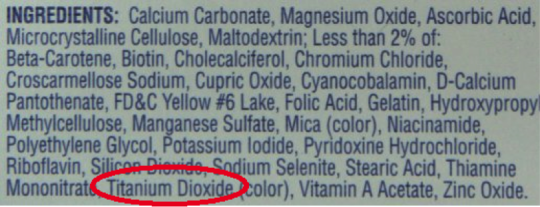
Titanium dioxide is listed as an ingredient in a popular multivitamin tablet.
Source: Amazon.com
This naturally occurring metal can cause lung inflammation and immune system issues in workers during production.6 And while exposure from taking a pill isn’t as drastic as that from working with it, you have to wonder what it might be doing to your body.
As it turns out, it may be doing a lot.
One study shows titanium dioxide can create a small amount of DNA damage. This means you’re getting a tiny dose of DNA damage every time you pop a vitamin.7
Yikes!
Yet again, our health is jeopardized for the aesthetics of supplements. I think I would rather swallow an ugly pill than damage my genetic code.
But since pretty pills sell, you need to make a few changes when buying supplements. Here are few things you can do to protect yourself…
![]() Vitamin Solutions
Vitamin Solutions
It’s pretty obvious the FDA is doing more to protect the big food suppliers than, you know, the food supply (of which supplements are technically a part) from these dangerous additives, so it’s up to you to find safe vitamins and supplements.
Here are a few ways to do that:
- Check the labels — if you see that your vitamin has addition color, make sure it’s from a vegetable source. Also be sure to look for an organic or GMO-free label to ensure you’re not consuming GMO oils or other GM products.
- Reach out to your supplement company and ask them about their ingredients. You can do this through their website or consumer hotline (always look for the number on the bottle before you purchase).
- Eat a variety of organic vegetables, fruits, and meats to get as many vitamins and nutrients as possible.
Live well,

Natalie Moore
Managing editor, Living Well Daily
P.S. Do you have supplement questions you would like answered? Send them in! We would love to answer them for you. Direct all questions to nmoore@lfb.org
Sources
[1] Multivitamin/mineral Supplements
[3] FDA Probes Link Between Food Dyes, Kids’ Behavior
[4] Living in Color: The Potential Dangers of Artificial Dyes
[5] Shining the Spotlight on Trans Fats
[6] Effects of Th1 and Th2 cells balance in pulmonary injury induced by nano titanium dioxide.
Written By Natalie Moore
Natalie Moore is a dedicated health researcher with a passion for finding healthy, natural, and science-based solutions. After a decade of direct healthcare experience in western and natural medicine, she was involved in public health research before joining Living Well Daily.
View More Free Articles
This Sleep Mistake Is Doubling Your Disease Risk
Think your inconsistent bedtime is just a harmless habit? Think again. New research reveals that going to bed at different times each night isn’t just making you tired—it could be dramatically increasing your risk of serious diseases. But the key to making sure poor sleep doesn’t derail your health goals likely isn’t what you think…....
Stop Obsessing Over Diet Trends
Can we stop with the endless diet debates already? Every other week there’s a new headline shouting about which diet is best for weight loss, heart health, or diabetes. Paleo, keto, low-carb, high-protein… it’s exhausting. And now, a new meta-analysis is out comparing the Mediterranean diet, the DASH diet, and something called AHEI (that’s “Alternative...
A New Reason to Ditch Processed Junk
If you’ve ever walked the inside aisles of your local grocery store and thought, “This is all just junk,” your instincts were spot on. A new study published in the journal Thorax just added another red flag to the list of dangers linked to ultra-processed food—a 41 percent higher risk of lung cancer. That’s right....
When Being Winded on Stairs Is Serious (And When It Isn’t)
I had an athlete visit me recently because he experienced shortness of breath while climbing stairs. He is in great shape, so he was worried about what it might mean. “Doc,” he said, “I run five miles three times a week. Why am I huffing and puffing after two flights of stairs?” His concern is...
Study EXPOSES Hidden Danger Lurking in Your Car
We think of our homes and cars as safe havens. But according to a startling new study, they may be flooding your lungs with microscopic plastic particles—every single day. Researchers in France recently found that adults inhale an average of 68,000 microplastic particles daily from indoor air alone. To put that in perspective, that’s about...
Mailbag: Is Modern Food Making You Snore?
“What can cause snoring, and is there a way to correct this issue?” —Seeking Silence Hi Seeking, Snoring happens when the soft tissues in your throat relax and vibrate as air passes through during sleep. While several factors can cause snoring—from sleep position to nasal congestion—I want to share one trigger that might surprise you....
Simple Food Swap SLASHES Dementia Risk 28%
Let’s be honest… who would jump at the chance to cut their dementia risk by 28 percent. And no, you don’t need to run marathons, survive on broccoli, or learn to play the zither (whatever that is) to make it happen. All it takes is one easy swap—something that’s probably already in your refrigerator. Researchers...
This SMART Floss Exposes Hidden Health Danger
Scientists have created dental floss that doesn’t just clean between your teeth—it also tracks your stress while you’re flossing. Now, I know what you’re thinking… “Great—now even flossing is going to stress me out by telling me how stressed I am.” But this fascinating new tool from Tufts University could be a game-changer for understanding...
Is This "Safe" Sweetener Damaging Your Brain?
The headlines are alarming… “Popular Sugar Substitute Linked to Brain Cell Damage” and “Erythritol Could Damage Critical Brain Barrier” are just two of the dozens I’ve spotted recently. But before you toss every sugar-free product in your pantry, let’s take a closer look at what this study actually shows—and what it doesn’t. The latest research...
This Summer Threat Could SPIKE Your Blood Sugar
Picture this… It’s another scorching hot summer day. You crank up the air conditioning while watching the weather forecast, which predicts yet another “record-breaking” heat wave. It’s starting to feel like just another miserably uncomfortable summer. But what you might not realize is that—if you have diabetes—those rising temps could do far more damage to...

